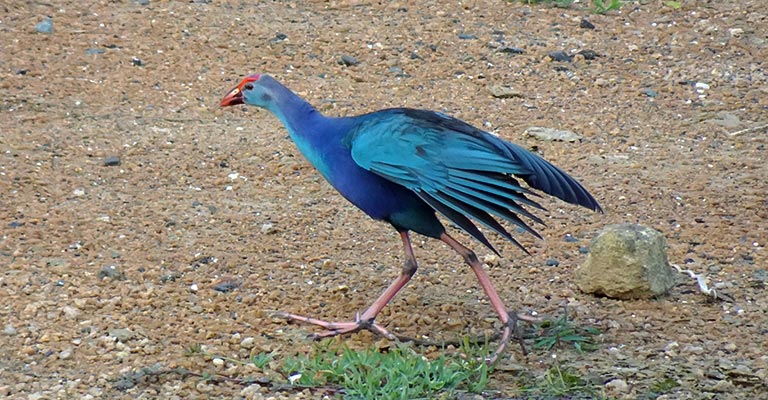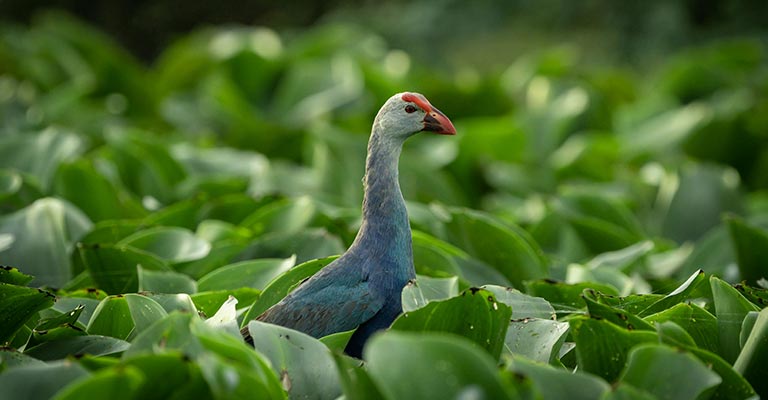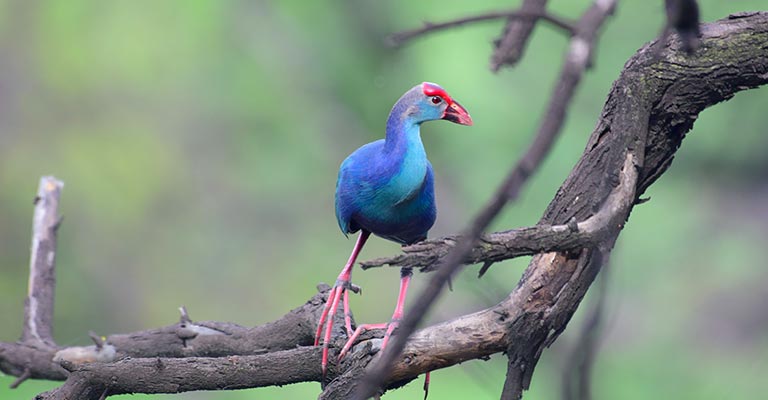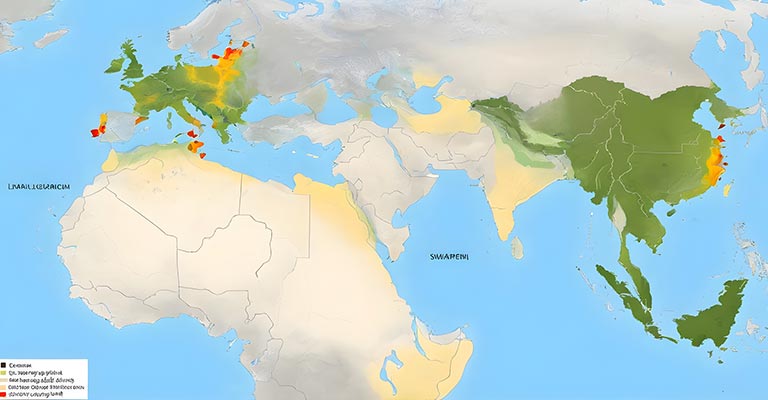Ever seen a bird that’s both an extraordinary swimmer and a splendid walker? Allow me to introduce you to the Grey-Headed Swamphen, an intriguing bird species that’s been turning heads in the ornithological world.
Flaunting vibrant plumage of purple-blue with a contrasting grey head and red beak, this bird is as pleasing to the eye as it is fascinating to study.
The Grey-Headed Swamphen isn’t just another pretty face in the avian world. What sets this creature apart from others is its unique lifestyle and habits.
Known for their long toes that help them walk on floating vegetation, these birds have adapted gracefully to their wetland habitats.
They’re also known for their distinctive call – a loud, quick “Kruk,” which can often be heard resonating in their natural environment.
From its distinctive coloration to its captivating behaviors, there’s no denying the allure of the Grey-Headed Swamphen. So, let’s dive deeper into understanding this notable species – I’m sure by the end, you’ll be as fascinated by these birds as I am!
Habitat and Distribution of Grey-Headed Swamphens

The Grey-Headed Swamphen, a bird of many environments, is accustomed to wetland habitats. Whether it’s marshes filled with reeds or swampy areas flourishing with water plants, these birds find comfort in places where the ground is soggy.
Thanks to their long toes that distribute weight evenly, they have a knack for trudging through mud and swimming across ponds.
Their distribution is quite broad, spanning different continents. You’ll spot them in South Asia, Southeast Asia, and Sub-Saharan Africa. It’s not uncommon to see them in Australia, either! Here’s an overview of their distribution:
| Continent | Reported Sightings |
|---|---|
| South Asia | Common |
| Southeast Asia | Abundant |
| Sub-Saharan Africa | Moderate |
| Australia | Occasional |
These swamphens are lovers of warmth; hence, they thrive in tropical and subtropical regions. Cold climates? Not so much! They avoid those frosty environments like the plague.
Interestingly, these birds aren’t sticklers for one place only; they’re somewhat migratory by nature. Food scarcity or weather changes can drive them to new territories without hesitation.
Now let me tell you about the uniqueness of these habitats – each offers something special that makes it perfect for the swamphens:
- Marshes: Their dense vegetation provides excellent cover from predators.
- Swamps: Rich in aquatic insects and other small creatures – a hearty buffet!
- Ponds: The shallow waters make it easy for these birds to hunt for food.
So there you have it! The habitat preference and geographical spread of this fascinating creature known as the Grey-Headed Swamphen truly paints a vivid picture of its adaptability and resilience.
Dietary Habits of These Unique Birds

Now, let’s dive into the dietary habits of these fascinating birds. With their vibrant plumage and distinctive red bills, grey-headed swamphens are primarily herbivores. They’re known to feed on a wide variety of aquatic vegetation.
Their typical menu includes tender shoots, leaves, seeds of marsh plants, and various fruits. From my observations in the field, I’ve noticed that they particularly like water hyacinth and wild rice. An interesting fact about these birds is that they occasionally indulge in animal matter.
Here’s a quick snapshot:
| Preferred Food | Frequency |
|---|---|
| Aquatic Vegetation | High |
| Seeds & Fruits | Moderate |
| Animal Matter | Low |
Adding to their uniqueness is how they eat. These birds use their muscular feet to pull food from under the water surface while using their sharp beak to cut through rigid plant materials.
When it comes to feeding on animal matter like snails or small insects, they display excellent skill in handling their prey.
Their diet significantly contributes to maintaining the ecosystem balance within marshlands as well. By feeding on invasive plants like water hyacinths, which can choke out native species if left unchecked, swamphens play a vital role in preserving biodiversity.
In summary, due to their dietary habits, grey-headed swamphens are captivating creatures and crucial players within our natural habitats.
Grey-Headed Swamphen: Reproduction and Lifespan

The reproduction of Grey-Headed Swamphens is genuinely a fascinating process. These birds are polygamous by nature, meaning one male can mate with multiple females.
Males become highly territorial during the breeding season, typically between March and July.
To woo their potential mates, males engage in an elaborate courtship display. They’ll puff up their feathers, spread their wings wide, and belt out a distinctive call that echoes through the marshlands. It’s like watching a Broadway show unfold right there in the wild!
Once successful in attracting a female, nest-building commences. Both partners contribute to this effort, but usually, the male collects materials.
At the same time, the female arranges them meticulously inside chosen spots within their territory – usually amidst dense vegetation close to water bodies for safety against predators.
| Stage | Duration |
|---|---|
| Egg incubation | 21-24 days |
| Fledging period | 40-50 days |
The average lifespan of Grey-Headed Swamphens is about 7 to 8 years in wild conditions. Still, when kept under human care or in captivity, these birds have been known to live up to 10 years, mainly due to reduced threats from predators and stable food sources.
Here are some quick facts:
- Grey-headed swamphens are monogamous
- Breeding season is from March-July
- The average lifespan is around 7-8 years
There are a few other things worth mentioning about these intriguing birds:
- Their nests are often built on floating vegetation.
- Females lay around three-to-eight eggs per clutch.
- Both parents share responsibilities in incubating eggs and rearing chicks until they are ready to fledge; this takes roughly six weeks.
Grey-Headed Swamphen Range Map

The Gray-headed Swamphen is an extensive rail bird that is native to southern Asia, the Middle East, and northern Thailand.
It was introduced to North America in the late 1990s due to avicultural escapes in the Pembroke Pines, Florida area.
The bird is brightly colored and has a massive red bill, making it easy to spot in southern Florida.
The range map for the Gray-headed Swamphen can be found on the All About Birds website.
Conclusion
The Grey-Headed Swamphen birds epitomize the marvels of nature with their distinct lifestyle and habitat preferences.
Through this exploration, we have uncovered the intricate relationship between these birds and their wetland habitats, highlighting the importance of preserving these ecosystems.
Their adaptable nature and resourceful behaviors showcase the resilience of avian species in the face of environmental challenges.
However, looming threats such as habitat loss and human interference underscore the urgent need for proactive conservation measures.
By fostering awareness and implementing sustainable practices, we can ensure the continued existence and thriving populations of Grey-Headed Swamphen birds for generations to come.